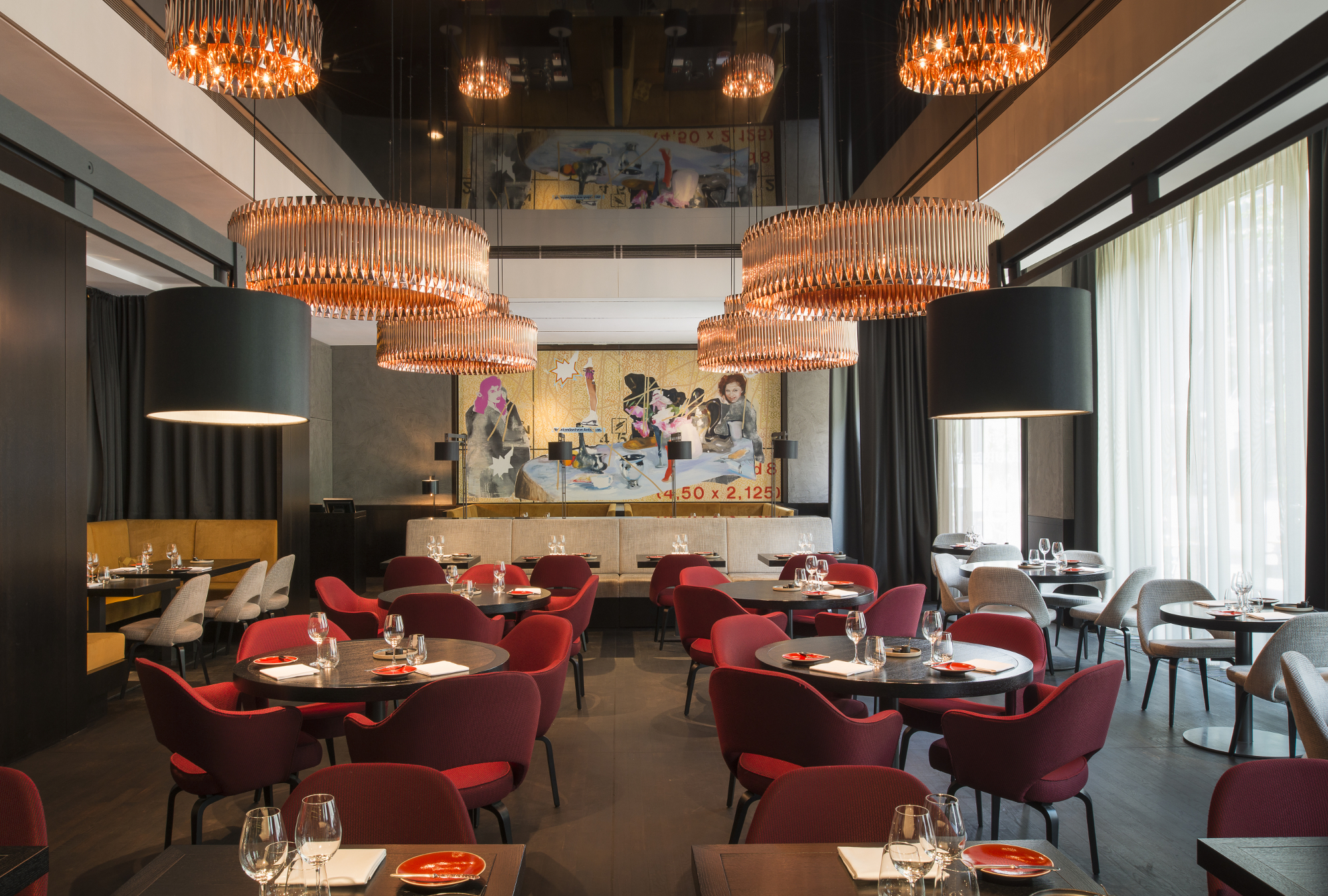It was a freezing Berlin night as the wind chased Charlotte and I through the door of the Sofitel Berlin Kurfürstendamm into a leather-curtained cubicle. There, momentarily befuddled by the lack of light, we groped our way into the chic modern interior of the restaurant. Le Faubourg – named for the French suburbs, which belies its prime location in Berlin’s luxury shopping area – has the sort of décor one would choose for a kitchen in which one will entertain as much as cook. Black lacquered tables without the fuss of linen and comfortable chairs in deep scarlet and contemporary greys sit under unusual light fittings made from copper pipes, while along one wall is a mural by German artist Junior Toscanelli, which appears to feature shining silverware, glamorous ladies and disembodied legs… Chilled music pervades but does not intrude.
Chef Felix Mielke is a Berliner with a passion for French cuisine, using fresh local ingredients to serve a menu which features French and German inspired dishes, with the interesting twist that one can choose a main course based on whether one wishes to have the central ingredient in a modern or classic style. We spent some time deliberating over these unusual additional choices as we looked at the menu, but our waiter Nicolas was ready with secure knowledge and genuine enthusiasm for the menu (as well as a couple of glasses of Taittinger Rosé) to help us decide.After we had made our choices, the service was responsive to our desired pace and Nicolas was charming throughout. An amuse-bouche of warming kohlrabi soup with yuzu cream and a crunchy-coated tuna praline loosened from us the last tendrils of the chilly winter weather outside and we were ready to embark upon an evening of excellent cuisine.
The menu suggests that starters are ‘to share’, so we had chosen a couple of our favourites and two extra plates were produced so that we might taste both dishes, a more civilised version of our our usual system, which is to swap plates at the halfway point! The goose liver was served as a disc of silky paté and the accompanying nut muesli, tangy sorrel gel and earthy sweetness from brightly coloured carrot provided a variety of flavour, colour and texture contrasts. The deer tartare was similarly well constructed, the finely minced, beautifully lean meat was served with beetroot pearls that contributed a woodsy sweetness, along with a hint of mustard and root vegetables. The wine was creamy and smooth, bringing out the saltiness of the food.
Our second wine, glittering with fine bubbles, was much more substantial and was able to withstand the deep flavours of the next course, a lobster bisque. Again, it was a dish in exceptional equilibrium, a caramel of bell pepper underneath the delicate lobster flesh and a bisque that was rich and salty.Unusually, we had both chosen fish for the main course, although the species and cooking differed. I had selected sturgeon and caviar in the traditional style, which had the dramatic flourish of caviar that was weighed and added at the table. It was a fresh flavoured dish and the sturgeon was deliciously meaty, the umami of mushrooms and the tang of pickled cucumber confidently paired with a light and well-balanced Sancerre.
Charlotte had opted for grouper from the nouveau side of the menu. The fish was perfectly cooked and served with saffron risotto; the risotto was the especially innovative element in that it was served as a cream – the rice having been cooked until it became completely smooth – and as a garnish of puffed rice. The enigmatic flavour of saffron was matched with a chardonnay. By itself, this wine was a little lacklustre, but might appeal more to chardonnay fans, even though it has a less fruity flavour than usually found in this grape.
At the end of the meal, we selected a couple of cheeses by Affineur Waltmann alongside a magnificent Oremus Szamorodni 2012 Tokaj, created through maturing grapes affected by a particular fungus to reduce water content and increase sweetness. The cheese selection was relatively small compared to those often seen in a French restaurant, but there were several mighty flavours tucked under the glass domes on the trolley. One of our favourites was an aged Brie, while a certain “farmer’s cheese” had the kind of punch in both flavour and aroma that might make even the most enthusiastic turophile run for the hills.Our final course, which appeared on the menu as simply ‘Bounty’ was indeed reminiscent of that coconut chocolate bar. It was a light mascarpone mousse encased in dark Manjari chocolate, with a smooth chocolate sauce served at the table. Hints of lime and coconut gave a tropical twist to the dish, which was speedily devoured and washed down with a dusky Graham’s 20 year aged Tawny Port.
Le Faubourg is an excellent place to experience the adventurous interpretation of European cuisine that seems to characterise the current Berlin food scene and the unique menu options also show an awareness of that cuisine’s heritage, with a masterful understanding of how contrasting flavours and textures contribute to a sublime dinner. It was a shame to have to leave the Sofitel Berlin Kurfürstendamm, as I am sure we would have headed to the bar to continue our delightful experience, then greatly appreciated a much shorter journey to our room! However, with heavy hearts and full stomachs, we bid farewell to Nicolas and wrapped up warm to face the windy Berlin night, which had been completely forgotten as we dined.
Restaurant Le Faubourg
Augsburger Strasse 41
10789 Berlin
Germany

